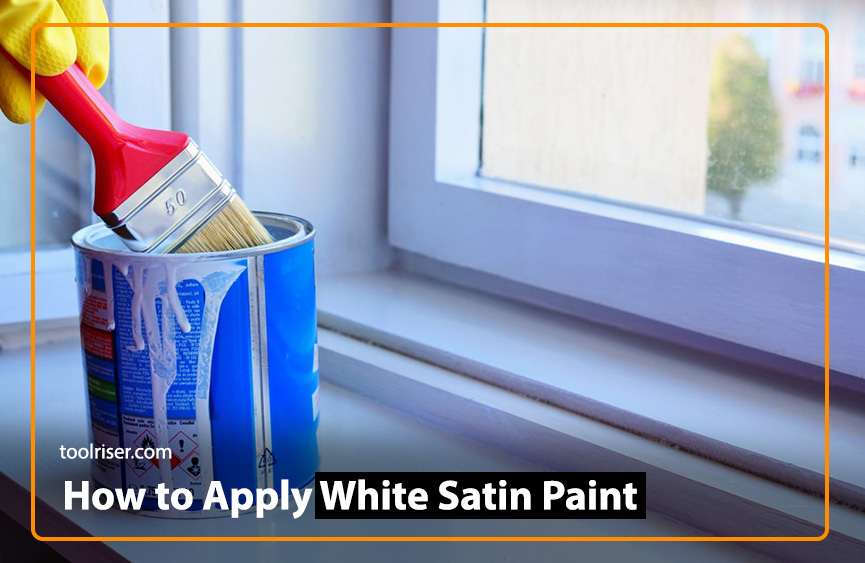What is White Satin Paint ? And How to Apply White Satin Paint for Woodwork

White satin paint is a popular choice for woodwork due to its smooth finish and durability. Applying white satin paint to woodwork requires precision and proper technique to achieve the desired results. In this blog post, we will discuss the step-by-step process of applying white satin paint for woodwork, along with the necessary tools and materials.
What is White Satin Paint
White satin paint is a type of paint known for its smooth, velvety finish. It provides a subtle sheen that adds elegance to woodwork while also offering durability and easy maintenance.
Preparation Steps
Before applying white satin paint to woodwork, proper preparation is essential to ensure a flawless finish.
Cleaning the Surface
Start by cleaning the wood surface thoroughly to remove any dirt, dust, or debris. Use a mild detergent solution and a clean cloth to wipe down the surface.
Sanding
Next, sand the wood surface to create a smooth and even base for the paint. Use fine-grit sandpaper to sand the wood in the direction of the grain, paying attention to any imperfections or rough spots.
Priming (Optional)
For better adhesion and a more uniform finish, consider applying a primer before painting. This step is optional but recommended, especially for porous or bare wood surfaces.
Tools and Materials Required
Before starting the painting process, gather the following tools and materials:
White satin paint
Primer (if necessary)
Paintbrushes or rollers
Sandpaper (fine-grit)
Painter’s tape
Drop cloths or plastic sheeting
Stir sticks
Paint tray
Gloves and safety goggles
Steps to Applying White Satin Paint
Once the preparation is complete and you have all the necessary tools and materials, you can begin applying the white satin paint to the woodwork.
Choosing the Right Brush or Roller
Select high-quality paintbrushes or rollers suitable for satin paint. For smaller areas or intricate details, use a brush, while rollers are more efficient for larger surfaces.
Applying the First Coat
Dip the brush or roller into the paint, ensuring it is evenly coated. Start by painting along the edges and corners before filling in the larger areas with smooth, even strokes. Apply the first coat of paint in thin layers to avoid drips or streaks.
Sanding Between Coats
After the first coat has dried completely, lightly sand the surface with fine-grit sandpaper to remove any imperfections or roughness. Wipe away any dust with a clean, damp cloth before applying additional coats of paint.
Applying Additional Coats (If Necessary)
Depending on the desired coverage and finish, you may need to apply multiple coats of white satin paint. Follow the same process of painting, allowing each coat to dry completely before sanding and applying the next coat.
Drying and Curing
Once you have achieved the desired coverage and finish, allow the painted woodwork to dry completely according to the manufacturer’s instructions. Proper drying and curing are essential for a durable and long-lasting finish.
Tips for a Professional Finish
Work in a well-ventilated area to ensure proper air circulation.
Avoid painting in extreme temperatures or humidity levels.
Clean brushes and rollers thoroughly after each use to prolong their lifespan.
Store leftover paint properly to prevent drying out or spoiling.
Take your time and apply paint carefully to achieve a professional-looking finish.
Conclusion
In conclusion, white satin paint is an excellent choice for woodwork due to its smooth finish and durability. Mastering the art of applying white satin paint for woodwork can transform any space into a masterpiece of elegance and durability. Remember the story of Jack, a DIY enthusiast who, armed with the right tools and knowledge, transformed his worn-out wooden cabinets into gleaming works of art By following the step-by-step process outlined in this blog post and using the right tools and materials, you can achieve professional results with ease.
For more information, you can read:- Top 5 Best White Satin Paint for Woodwork: 2024 Review
FAQs
Can I use white satin paint directly on bare wood?
While it’s possible, it’s recommended to use a primer for better adhesion and a more uniform finish.
How long does white satin paint take to dry?
Drying times vary depending on factors such as temperature and humidity, but it typically takes a few hours to dry to the touch and 24 hours to cure fully.
Can I apply white satin paint over existing paint?
Yes, as long as the surface is clean and properly prepared, you can apply white satin paint over existing paint.
Do I need to sand between coats of paint?
Yes, lightly sanding between coats helps achieve a smoother finish and improves adhesion.
Can I use a brush instead of a roller for painting woodwork?
Yes, brushes are suitable for smaller areas and detailed work, while rollers are more efficient for larger surfaces.
How long does white satin paint last on woodwork?
With proper preparation and maintenance, white satin paint can last for several years before needing to be repainted.






